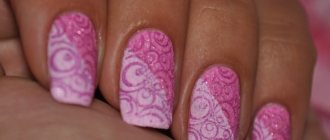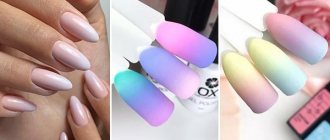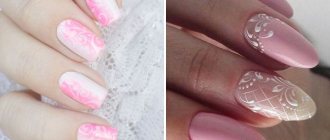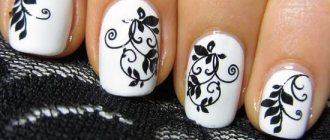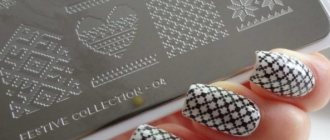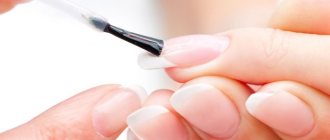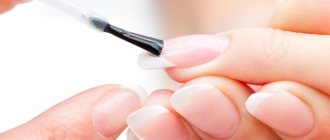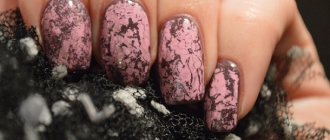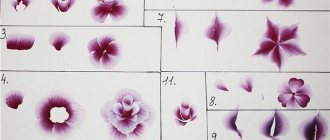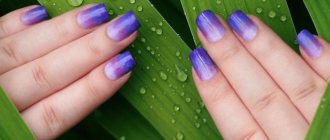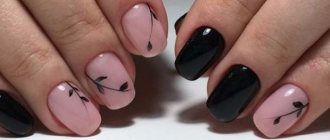Chinese painting is one of the increasingly popular styles in nail art. It is distinguished by its particular lightness, airiness and femininity, as well as a rather complex drawing technique, which is why it is so valued among the female half of the population. Unique designs are applied to the nail surface with acrylic, creating a three-dimensional three-dimensional image. The most popular are floral and plant motifs, but they are diluted with figures of birds or animals.
The style of Chinese nail painting became famous relatively recently, at the end of the 20th century. This followed the patented discovery of the "one stroke" technique by artist Donna Dewbury in the 1970s. Before her, a similar design had been done with Gzhel-style painting, and after Donna’s patent it received a new round of development. Now manicure specialists can use the Chinese style to paint entire pictures that amaze with their beauty.
Chinese nail painting for beginners
The technique of drawing on the nail plate in the Asian style is usually used on long or extended nails, because... To create a three-dimensional drawing you need space.
On short ones, small elements are often drawn. Beginners need to consider a few tips before drawing:
- The most convenient way to master design is by practicing on paper or using tips.
- Watch a video on the Internet with lessons on how to create a step-by-step manicure with Chinese painting.
- Prepare the necessary materials: paints, brushes, water, etc.
- Draw a sketch after practicing on a piece of paper.
- Clean and degrease the surface of the nail, cover with base. If you plan to paint extended nails, apply gel and the main color of the polish.
- To perfect the design, first choose simple flowers, for example, a rose or others.
Techniques for drawing roses
The main types of strokes in Chinese painting Masters distinguish not many strokes and they are easy to remember:
- Smooth surface - created without lifting the brush from the surface;
- openwork - the stroke is uneven because the brush works up and down;
- semi-openwork - loops are threaded;
- wave - to create this stroke you need to make a slight twisting movement with the brush while drawing.
But if you manage to overcome your impatience, the result will simply stun you! In addition, once you are immersed in the atmosphere of this craft, you will be able to find peace and tranquility in this work.
Painting for beginners video
https://youtube.com/watch?v=Z9u1-tdflBY
Of course, it is impossible to wear such a work of art every day. It would be better if this type of manicure becomes a special, festive option for you, the creation of which you will approach with special trepidation.
And we can assure you that your work will definitely not go unnoticed; Chinese painting will not only attract attention, but will also indicate your refined, incomparable taste. https://www.youtube.com/embed/nVRb7e_xDbc
How to Draw Chinese Painting
The main secret of Chinese manicure on nails lies in the special brush strokes that the master uses. In each image you can see the standard elements for this style:
- Wave. It is drawn with small swirls sliding along the surface of the nail plate.
- Feathers. Sharp brush strokes up and down.
- Watercolor. Blurred, translucent decorative elements.
- Openwork. It occurs when paint is applied unevenly using vertical movements.
- Semi-open. Small loops, for which the tassel is drawn first upward, then sideways and downwards.
- Smooth surface. Apply with one touch, without lifting off the surface.
Pastel-colored varnish is most often used as a background shade, and darker shades are used less often. Brush strokes are applied with two shades of paint, which are applied side by side on the palette in advance (can be in two stripes or in two drops). Using a flat brush with both shades, the pattern is applied to the background in one motion, with a few strokes forming an interesting and memorable nail design with Chinese painting.
How to place paints on a palette?
We apply paired tones to the foil immediately so that they are present during the creation of the main pattern. Place a pile of light paint and a dark tone in different places on the palette. Then use a flat brush to make broad strokes without turning the tool. The brush produces two colors, and in the middle of the palette another mixed tone is created - a transitional one.
We apply paired tones to the foil immediately so that they are present during the creation of the main drawing
Place a pile of light paint and a dark tone in different places on the palette. The brushes produce two colors, and in the middle of the palette another mixed tone is created - a transitional one.
You can do it differently. Contrasting tones are applied to the palette in two parallel stripes, the width between them is slightly larger than the stripes themselves. This is the more commonly used method by craftsmen of applying paint to a palette.
Applying a pattern to the nail surface
It is important to make strokes with confident, precise brush movements. To get the first petal, place a flat brush with paint applied to it on the nail and turn it in a smooth motion
The result is the first element.
It is important to make strokes with confident, precise movements of the brush. To obtain the first petal, place a flat brush with paint applied on it to the nail and turn it with a smooth movement. When drawing, you can experiment with the inclination and angle of movement of the brush.
In drawing, you can experiment with the tilt and angle of brush movement. The result is beautiful, unusual strokes from which you can create new designs and fabulous flowers. Artistic thinking and imagination of the artist dictates new images for miniatures on nails
It is not important here that the shapes and sizes of flowers are repeated on the nails. To prevent them from looking like stencil images, each element should be slightly different from the others
Then it will be a real artistic image. It is important to maintain the style and color combination in each drawing.
Artistic thinking and imagination of the artist dictates new images for miniatures on nails. Flowers can be of different sizes, over time the hand will become full and they will look more like one another
Flowers can be of different sizes, over time your hand will become full and they will be more similar to one another.
Required tools and materials
Before you start painting on your nails, you should prepare the necessary materials. To create pictures you will need: acrylic paints, brushes, paper napkins or towels, a jar of water, a palette for mixing colors, base and top coat, the main background shade, and, if necessary, extension gel. All these components are necessary for the painting itself; before it, the nails need to be processed, removing the cuticle and filing it in shape.
Design Features
This technique involves drawing with strokes, painting with a flat brush, the manicure turns out to be very elegant, realistic, and voluminous. It's like there are real flowers on your nails! The technique can be quickly mastered, it is not at all difficult to perform, but there are still some features.
Necessary materials:
- brushes (flat, round);
- varnishes (different colors) or acrylic paints for painting on nails;
- a jar of water (for washing brushes);
- napkins, paper towels or a cloth (to remove excess water and paint);
- lamp for drying varnish; decorations (glitter, stickers, etc.).
All necessary materials can be purchased at specialized manicure stores.
Brushes are very important. The evenness and correctness of the stroke depend on them
Brushes need flat and round. Moreover, the bristles on them must be smoothed, otherwise the stroke will be sloppy. Brushes are needed with the smallest numbers (1 or 2).
Types of strokes
There are few strokes, but you need to practice well with them, it is important to make strokes of the correct shape and select colors so that they combine with each other and the transitions from one color to another are smooth. So, the main types of strokes:
- Smooth surface. An even stroke that is drawn without lifting the brush from the work.
- Openwork. A stroke that is depicted by moving the brush up and down.
- Semi-open. This is drawing with loops.
- Feather strokes. Strokes obtained by brush strokes.
- Wave. Swirled strokes performed without lifting the brush from the work.
Brushes for Chinese painting
When buying brushes, it is better to choose natural bristles. The artist's kit should include flat brushes (both with a beveled edge and a straight one) - they are used to paint flower petals, leaves and buds. Round brushes are needed for painting small details, and fan brushes are indispensable for applying grass. It’s also good to have a sponge brush in your arsenal - this is a new thing in the artistic world, but it’s convenient for making a smooth transition from one color to another (tutorials on creating amber can be found in the form of photos or videos on the Internet separately).
How to draw: step by step
As a sample, prepare a sketch on paper or type. This way, or based on the photo, it will be much easier for beginners to do Chinese nail painting.
- Stage I. We process the nails by doing a trim or hardware manicure: trim the cuticle, straighten the shape, get rid of unevenness using a nail file and buff. We clean our hands with an antiseptic, degrease the surface of the nail plate and apply a base: varnish, gel or other.
- Stage II. Cover the nails with a background shade. It is better for a novice master to choose neutral pastel options.
- Stage III. We apply two colors to the palette: dark and light. Dip the brush into both colors at the same time, so that one shade is on one side and the other is on the opposite side.
- Stage IV. Transferring the outlines of the image onto the nail, marking the boundaries of the composition, its location. We draw flowers, focusing on the sketch, with smooth brush movements. After drawing the main elements with a thin brush, add small details: stems, leaves, etc.
- V stage. We cover the finished painting with a finishing coat.
Tips for Beginners
Sketching on paper
When practicing on paper, the master does not take into account the texture of the surface. The brush does not glide on paper and moves with difficulty. Therefore, it is difficult to calculate the accuracy of movements on paper. Working with a pattern on paper is important because the master fully represents the finished drawing. Then it is easier to implement it on the surface of the nail. You can learn to draw small details and elements of floral patterns. By drawing a sketch on paper, you can calculate the proportions of the drawing. This is necessary at the initial stage of work. A novice artist finds it difficult to fit into the boundaries of the nail field.
When training on paper, the master does not take into account the texture of the surface. Therefore, on paper it is difficult to calculate the accuracy of movements
Working with a pattern on paper is important because the master fully imagines the finished drawing
First you need to learn how to draw individual elements - petals, buds, buds. It is better to do this on thick glossy paper. Features of applying the background. A smooth matte background is the key to a high-quality drawing on it. It should not contain any bumps or dents. In this case, the image of the main elements of the picture is distorted. The strokes will fall through or roll off the bumps. After applying the background, you need to wait for it to dry completely.
First you need to learn how to draw individual elements - petals, buds, buds
It is not necessary to repeat the pattern of the previous one on the next nail.
The composition made on all nails looks original. For example, when depicting a sakura branch, we place its beginning on the index finger, and the end of the drawing will be on the nail of the little finger
It is not necessary to repeat the pattern of the previous one on the next nail. The composition made on all nails looks original. For example, when depicting a sakura branch, we place its beginning on the index finger, and the end of the drawing will be on the nail of the little finger
Such an image will definitely attract attention and cause envy.
Creating a nail design is accessible to every woman
This is a creative process that brings satisfaction, creates beauty, and generates income.
A useful and enjoyable activity immerses you in the atmosphere of Japanese peace and philosophical contemplation of the surrounding reality.
Creating a nail design is accessible to every woman. This is a creative process that brings satisfaction, creates beauty, and generates income. A useful and enjoyable activity immerses you in the atmosphere of Japanese tranquility and philosophical contemplation of the surrounding reality. You feel peace and relaxation when creating new compositions on paper, satisfaction with your work when you see your drawings on women’s nails.
We must remember that an exquisite and colorful Chinese ornament is not suitable for everyday manicure. This is a luxurious addition to your holiday look. It is suitable for a ceremonial appearance, a special occasion.
The color scheme of the manicure should be combined with the toilet. You cannot have black and red roses on your nails to match a light dress.
The color scheme of the manicure should match the toilet. You can't put black and red roses on your nails to match a light dress. And vice versa, light flowers will be lost in the shine of New Year's sequins. Flowers on your nails can be decorated a little with sparkles.
Paints for Chinese painting
Acrylic is usually used as the main material for painting in Chinese style. Such dyes are the most convenient and non-toxic, and are made on an oil basis. These paints are ideal: they have a thick consistency that allows you to create bright colored paintings.
Among acrylic paints, the master should choose high-quality materials that will not crack or chip when worn. You can choose artistic acrylic - it is suitable for home use and training, and its characteristics are not very different from materials for nail art professionals.
Peculiarities
Example of painting As the training shows, artistic painting of nails is often performed on extended nails.
This is due to the fact that they have sufficient area to obtain a high-quality and complex pattern. In addition, the extended plates are very smooth, and therefore the paint adheres better. However, if your own nails are long enough, you can try painting on them too. But first they need to be thoroughly polished and a protective base applied, preferably in two layers. But applying a large number of layers of varnish reduces the durability of the manicure, this should be remembered.
As video lessons and other teaching of such painting show, it must be secured with a good quality top varnish. It is also better to apply it in two layers, since chipping it can ruin your manicure almost instantly. The fact is that both acrylic and watercolor are not only easily mixed with water, but also easily washed off with it. Therefore, it is very important to carefully seal the free edge of the nail.
Chinese rose on nails
Roses are considered one of the main floral elements of style. Her image can be found in almost every photo of Chinese nail painting. To practice drawing it, it is better to use paper media, which will help in choosing colors and applying strokes. When drawing already on the nail plate, you will first need to carry out the standard preparation procedure: trimming the cuticle, giving the desired shape, filing and applying a base with a background. After all the preparatory procedures, paints of pink and white shades are applied to the palette, the border between them is slightly shaded. Using a flat brush, dip in both colors at the same time and, using a twisting semicircular motion, make a stroke shaped like the English letter U. Similarly, make an inverted convex stroke over it. If desired, the flower can be left as is, or you can add a few more petals using the same principle. After the flowers are drawn, use a thin brush to add the stems, bud cup and leaves. When the image dries, it must be secured with a finishing transparent coating.
After practicing drawing roses, you can begin to more complex elements and new items in Chinese style painting: sakura, lilac, lilies, peonies, etc. Pay special attention to details: the veins on the petals, the centers of flowers. This will make the image more interesting and realistic.
What do they draw on the plates?
First of all, these are beautiful flowers.
Roses. To create a queen of flowers, the play of shades, proper darkening and lightening of the petals is very important.
Peonies. The petals of a lush flower are arranged in several layers. Performed using wavy strokes.
Poppies. An extremely colorful, passionate flower for those who love bright designs.
Sakura. Delicate pink or white flowers add femininity to the look.
An excellent addition to the composition are green petals and stems. For festive events, glitter is applied to the plates. In addition, landscapes, birds and animals are also painted using the Chinese painting technique.
